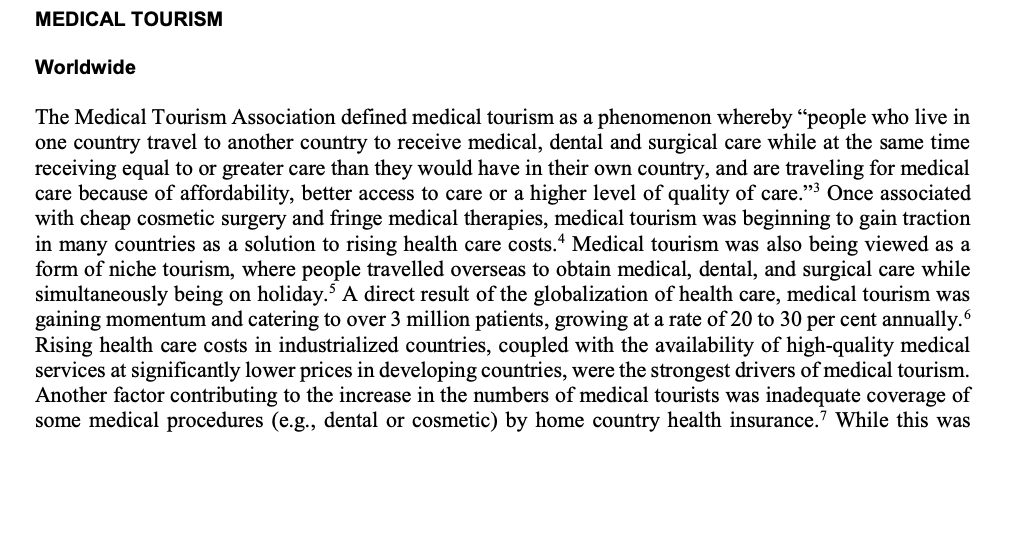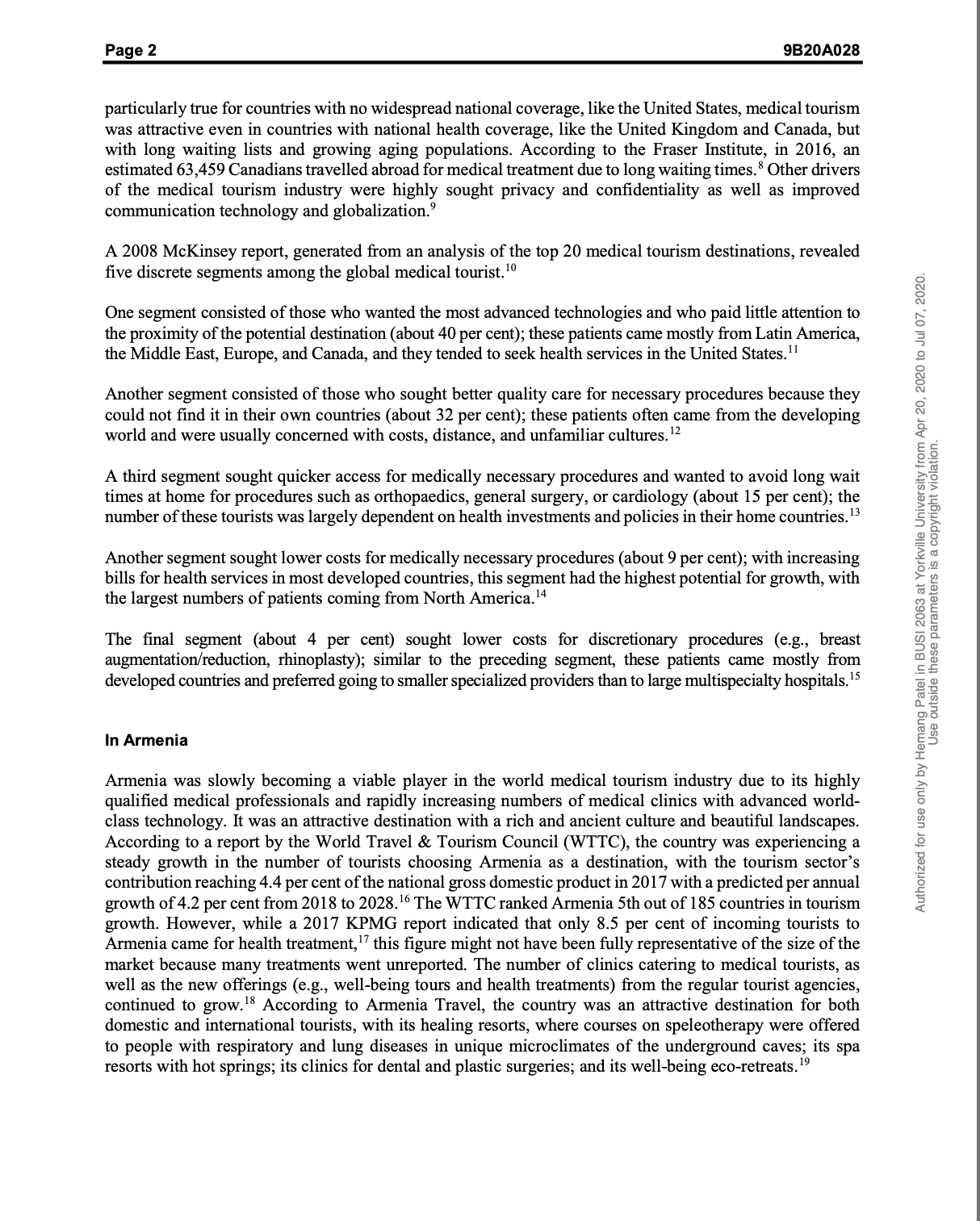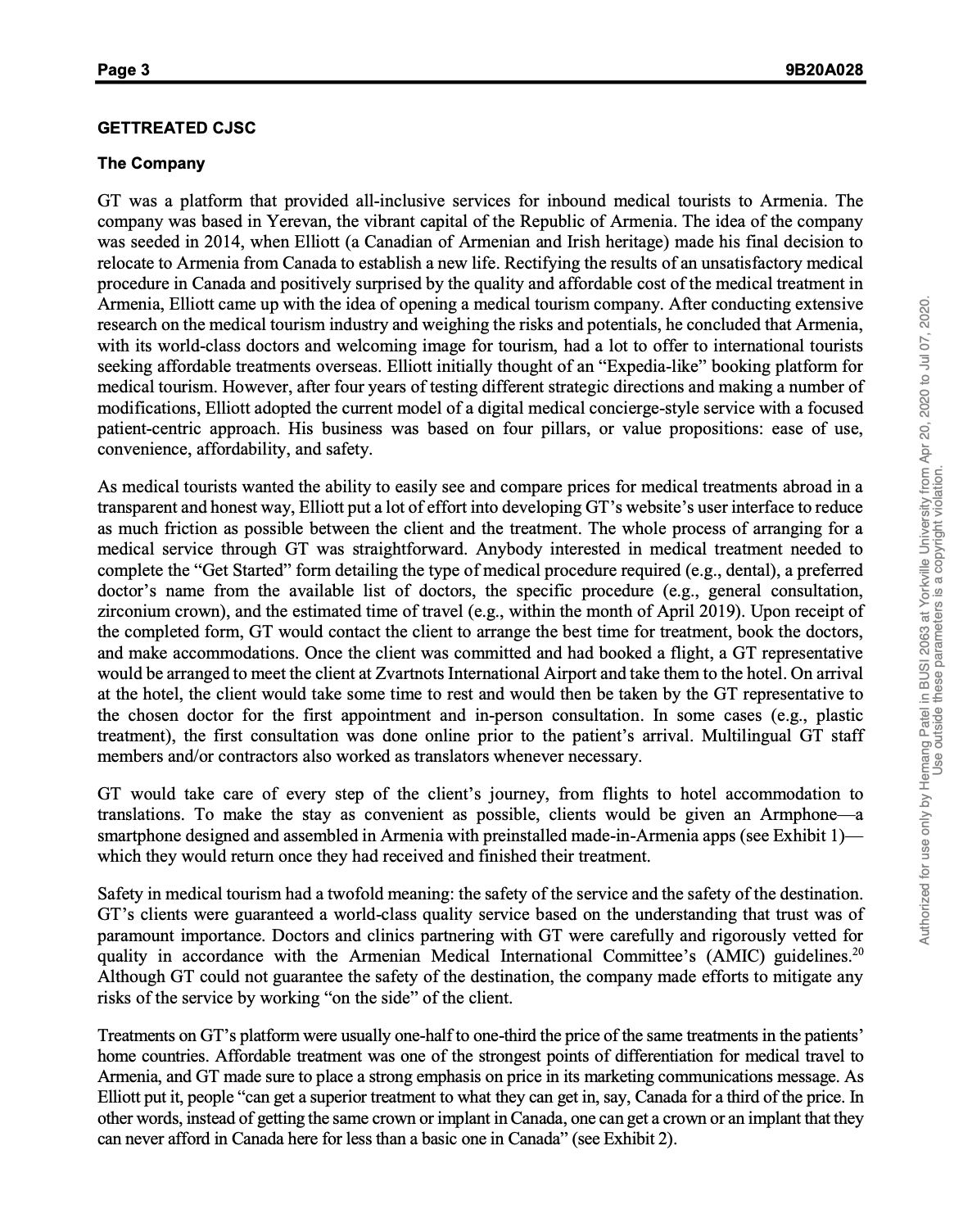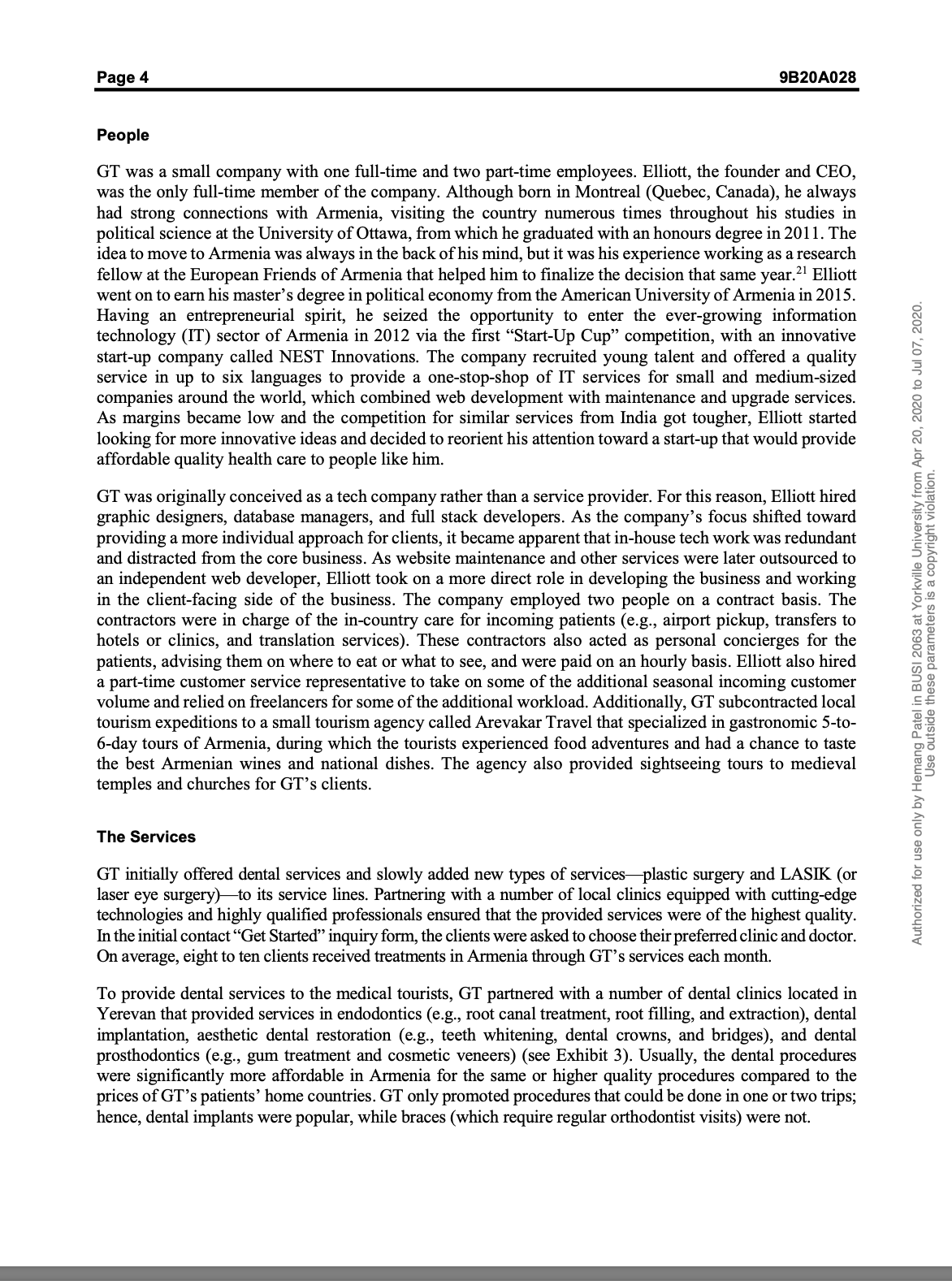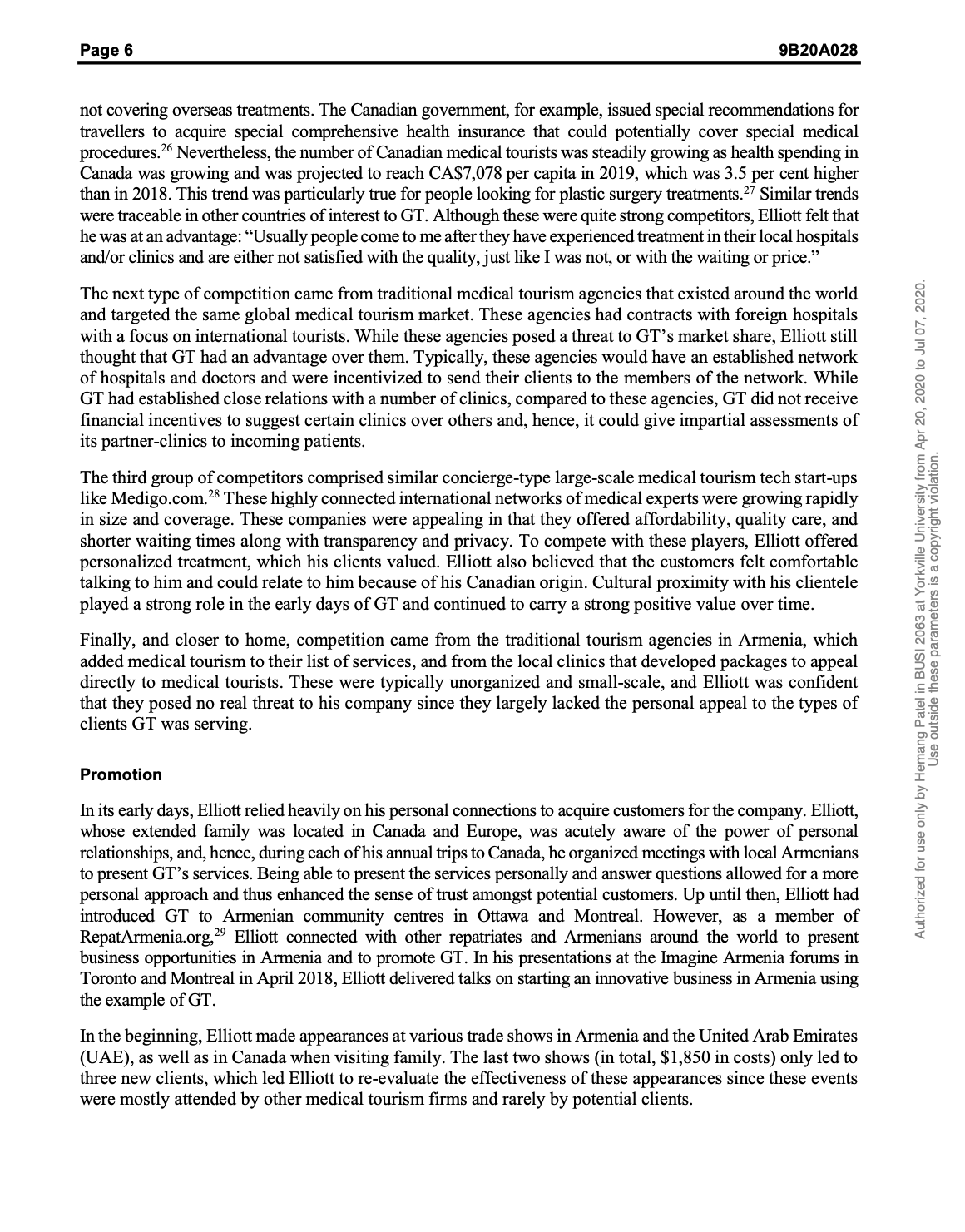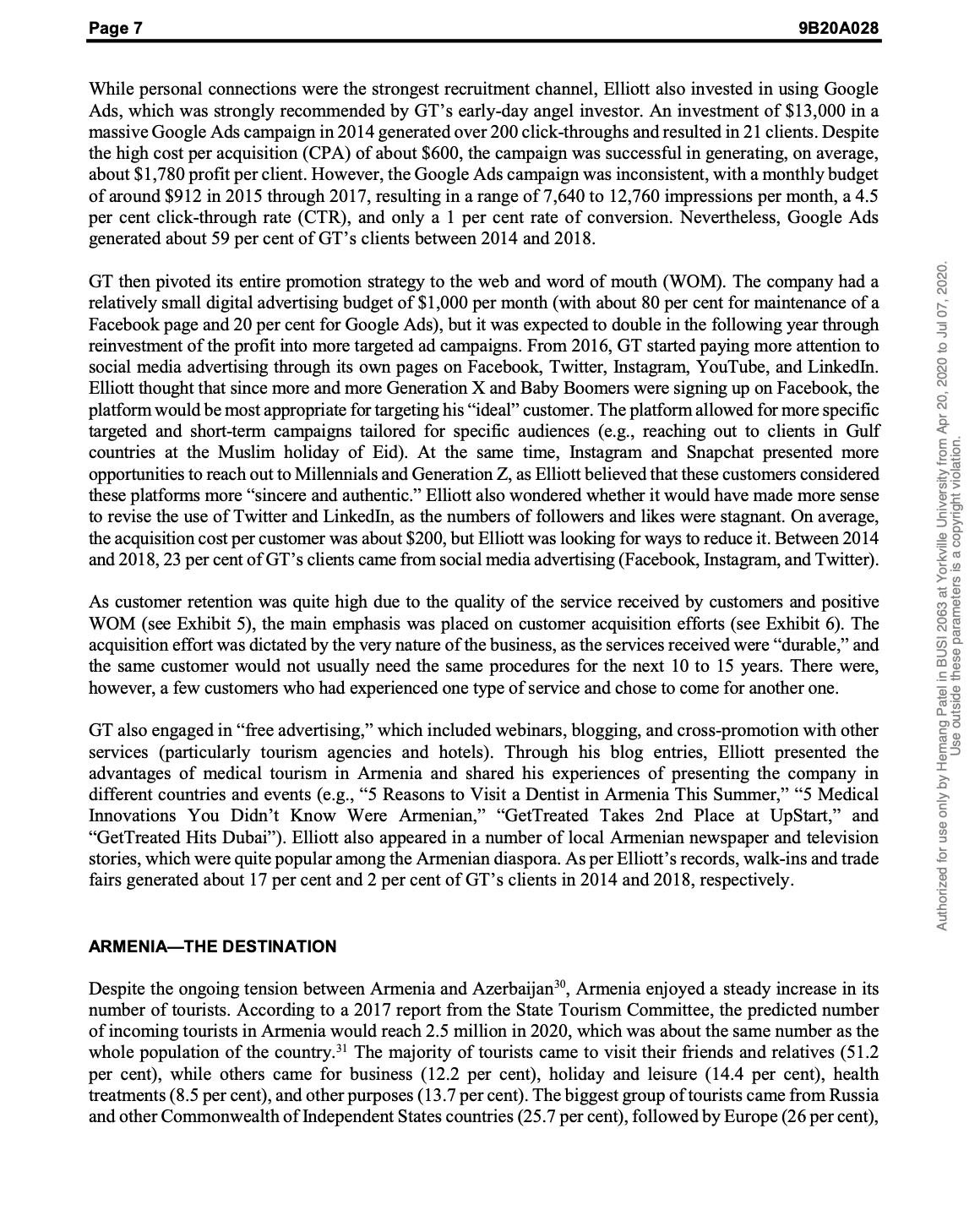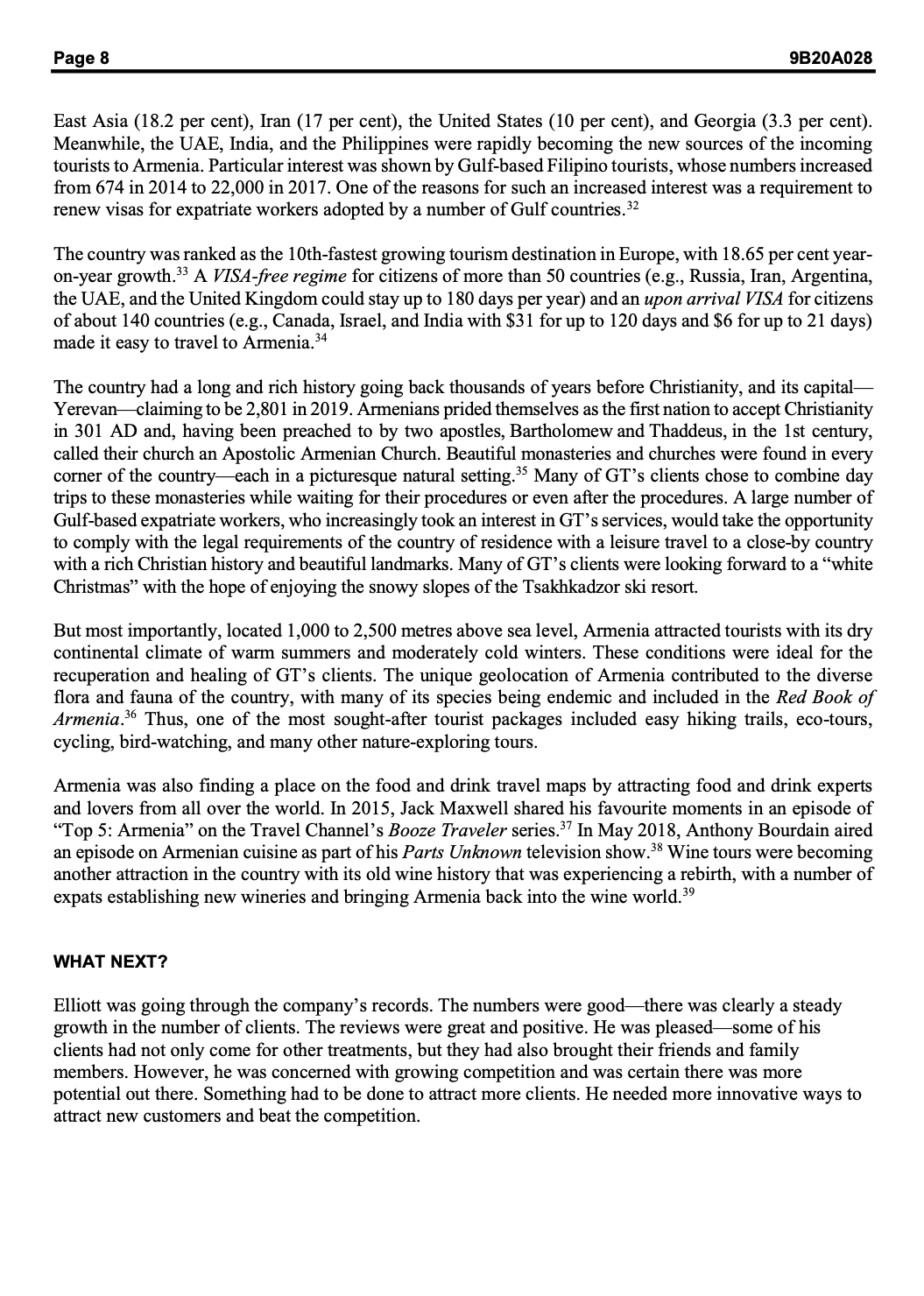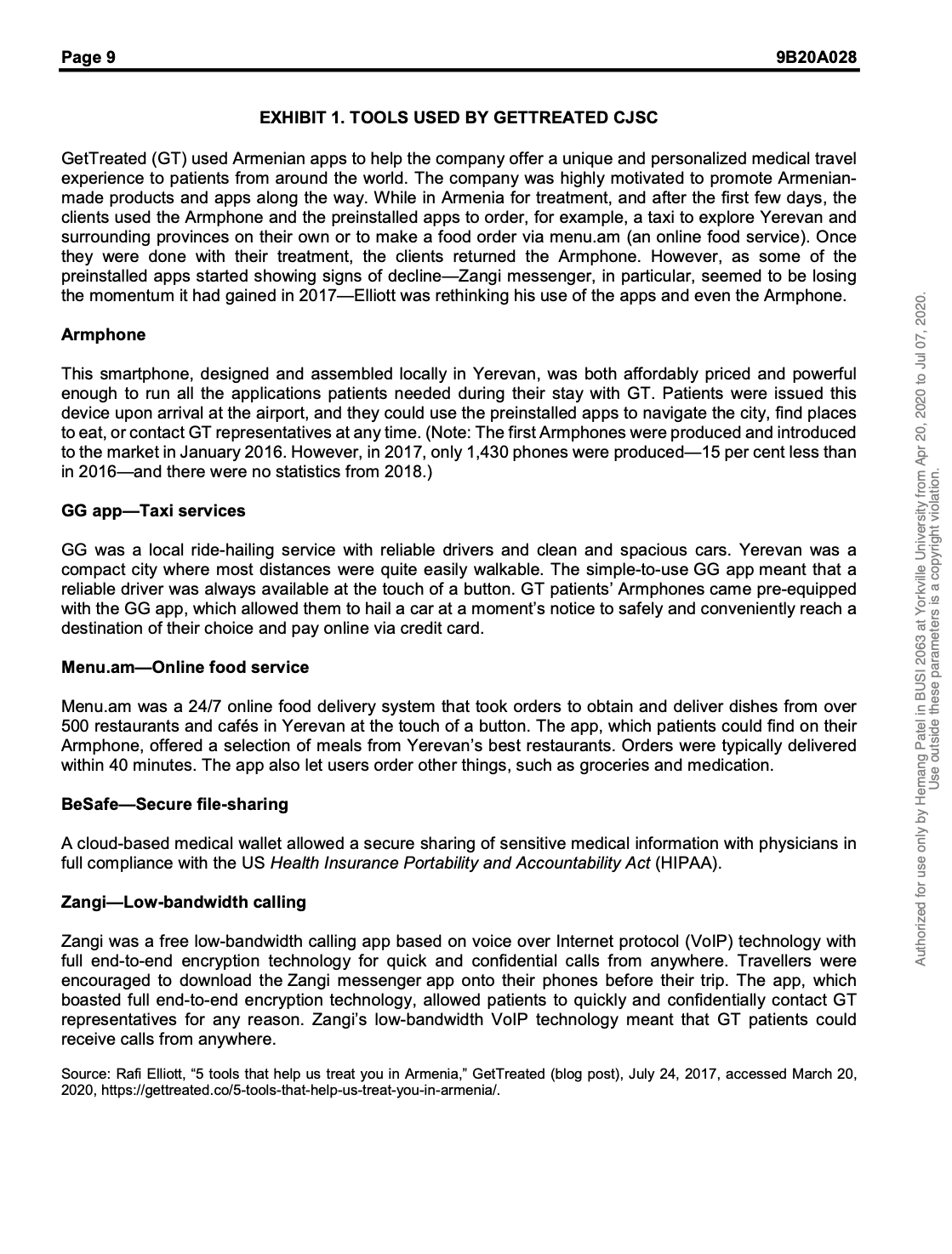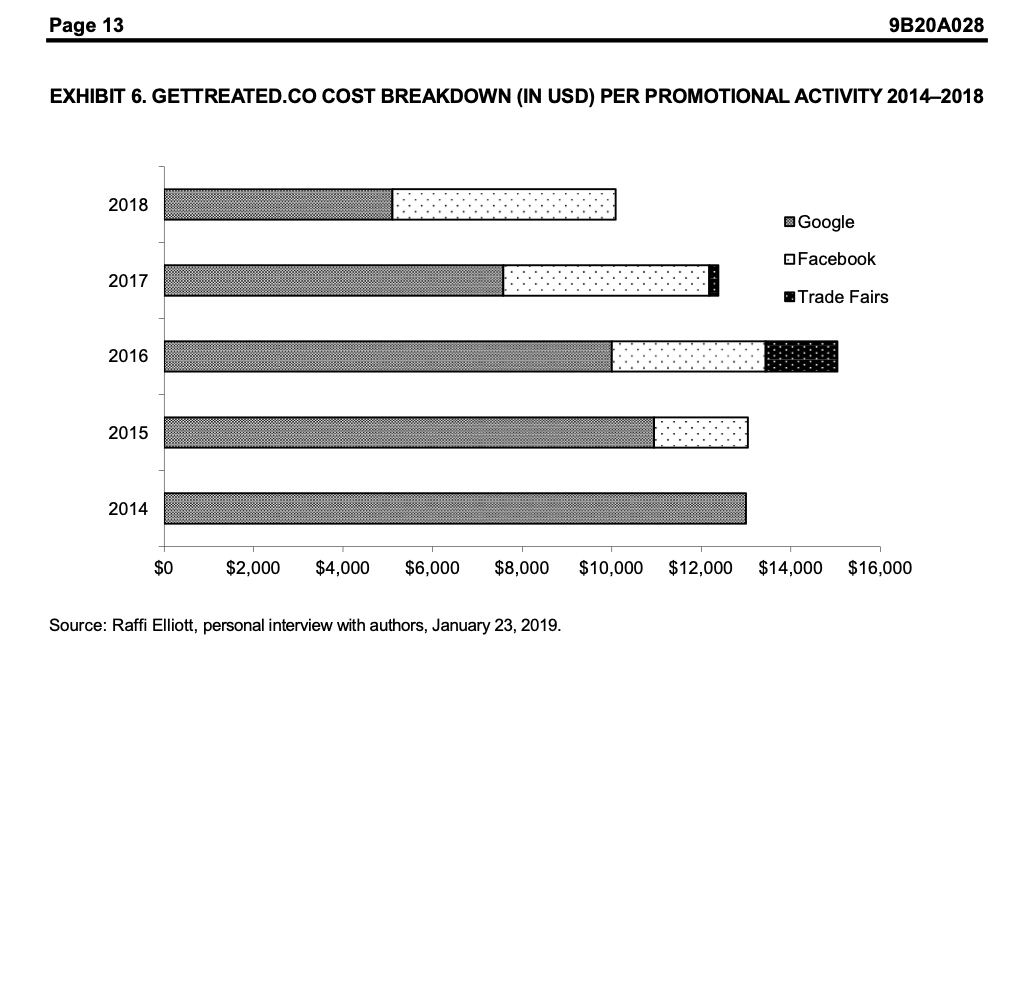1- Start by identifying the problem, or in other words what you think needs to be solved and discuss it in relevant detail.
2- List and discuss relevant facts from the case that are directly associated with the identified problem.
3- Discuss relevant marketing concepts, that may be applied in this situation and elaborate their relevance in this case.
4-Recommendation: After identifying the problem, and discussing the applicable marketing concepts, make two to three recommendations (or in other words the best course of action to deal with the problem).
5. Finish the discussion by choosing one course of action and explain why this is the best choice.
MEDICAL TOU RISM Worldwide The Medical Tourism Association defined medical tourism as a phenomenon whereby \"people who live in one country travel to another country to receive medical, dental and surgical care while at the same time receiving equal to or greater care than they would have in their own country, and are traveling for medical care because of affordability, better access to care or a higher level of quality of care.\"3 Once associated with cheap cosmetic surgery and fringe medical therapies, medical tourism was beginning to gain traction in many countries as a solution to rising health care costs\" Medical tourism was also being viewed as a form of niche tourism, where people travelled overseas to obtain medical, dental, and surgical care while simultaneously being on holiday.5 A direct result of the globalization of health care, medical tourism was gaining momentum and catering to over 3 million patients, growing at a rate of 20 to 30 per cent annually.6 Rising health care costs in industrialized countries, coupled with the availability of high-quality medical services at signicantly lower prices in developing countries, were the strongest drivers of medical tourism. Another factor contributing to the increase in the numbers of medical tourists was inadequate coverage of some medical procedures (e.g., dental or cosmetic) by home country health insurance.7 While this was Page 2 SBZOAOZS particularly true for countries with no widespread national coverage, like the United States, medical tourism was attractive even in countries with national health coverage, like the United Kingdom and Canada, but with long waiting lists and growing aging populations. According to the Fraser Institute, in 2016, an estimated 63,459 Canadians travelled abroad for medical treatment due to long waiting times. Other drivers of the medical tourism industry were highly sought privacy and condentiality as well as improved communication technology and globalization? A 2008 McKinsey report, generated from an analysis of the top 20 medical tourism destinations, revealed ve discrete segments among the global medical tourist.\" One segment consisted of those who wanted the most advanced technologies and who paid little attention to the proximity of the potential destination (about 40 per cent); these patients came mostly from Latin America, the Middle East, Europe, and Canada, and they tended to seek health services in the United States.11 Another segment consisted of those who sought better quality care for necessary procedures because they could not find it in their own countries (abOut 32 per cent); these patients often came from the developing world and were usually concerned with costs, distance, and unfamiliar cultures. '2 A third segment sought quicker access for medically necessary procedures and wanted to avoid long wait times at home for procedures Such as orthopaedics, general surgery, or cardiology (about 15 per cent); the number of these tourists was largely dependent on health investments and policies in their home countries. 13 Another segment sought lower costs for medically necessary procedures (about 9 per cent); with increasing bills for health services in most developed countries, this segment had the highest potential for growth, with the largest numbers of patients coming from North America.\" The nal segment (about 4 per cent) sought lower costs for discretionary procedures (e.g., breast augmentation/reduction, rhinoplasty); similar to the preceding segment, these patients came mostly from developed countries and preferred going to smaller specialized providers than to large multispecialty hospitals.15 In Armenia Armenia was slowly becoming a viable player in the world medical tourism industry due to its highly qualied medical professionals and rapidly increasing numbers of medical clinics with advanced world- class technology. It was an attractive destination with a rich and ancient culture and beautiful landscapes. According to a report by the World Travel & Tourism Council (WTTC), the country was experiencing a steady growth in the number of tourists choosing Armenia as a destination, with the tourism sector's contribution reaching 4.4 per cent of the national gross domestic product in 2017 with a predicted per annual growth of 4.2 per cent from 2018 to 2028.16 The WTTC ranked Armenia 5th out of 185 countries in tourism growth. However, while a 2017 KPMG report indicated that only 8.5 per cent of incoming tourists to Armenia came for health treatment,\" this gure might not have been fully representative of the size of the market because many treatments went unreported. The number of clinics catering to medical tourists, as well as the new offerings (e.g., well-being tours and health treatments) from the regular tourist agencies, continued to grow.18 According to Armenia Travel, the country was an attractive destination for both domestic and international tourists, with its healing resorts, where courses on speleotherapy were offered to people with respiratory and lung diseases in unique microclimates of the underground caves; its spa resorts with hot springs; its clinics for dental and plastic surgeries; and its well-being eco-retreats.19 Authorized tor use only by Hemang Patel in BUSI 2063 at Yorkville University from Apr 20, 2020 to Jul 07, 2020. Use outside these parameters is a copyright violation. Page 3 9B20A028 GETTREATED CJSC The Company GT was a platform that provided all-inclusive services for inbound medical tourists to Armenia. The company was based in Yerevan, the vibrant capital of the Republic of Armenia. The idea of the company was seeded in 2014, when Elliott (a Canadian of Armenian and Irish heritage) made his nal decision to relocate to Armenia from Canada to establish a new life. Rectifying the results of an unsatisfactory medical procedure in Canada and positively surprised by the quality and affordable cost of the medical treatment in Armenia, Elliott came up with the idea of opening a medical tourism company. After conducting extensive research on the medical tourism industry and weighing the risks and potentials, he concluded that Armenia, with its world-class doctors and welcoming image for tourism, had a lot to offer to international tourists seeking affordable treatments overseas. Elliott initially thought of an \"Expedia-like" booking platform for medical tourism. However, after four years of testing different strategic directions and making a number of modications, Elliott adopted the current model of a digital medical concierge-style service with a focused patient-centric approach. His business was based on four pillars, or value propositions: ease of use, convenience, affordability, and safety. As medical tourists wanted the ability to easily see and compare prices for medical treatments abroad in a transparent and honest way, Elliott put a lot of effort into developing GT's website 's user interface to reduce as much friction as possale between the client and the treatment. The whole process of arranging for a medical service through GT was straightforward. Anybody interested in medical treatment needed to complete the \"Get Started" form detailing the type of medical procedure required (e.g., dental), a preferred doctor's name from the available list of doctors, the specic procedure (e.g., general consultation, zirconium crown), and the estimated time of travel (e.g., within the month of April 2019). Upon receipt of the completed form, GT would contact the client to arrange the best time for treatment, book the doctors, and make accommodations. Once the client was committed and had booked a ight, a GT representative would be arranged to meet the client at Zvarmots International Airport and take them to the hotel. On arrival at the hotel, the client would take some time to rest and would then be taken by the GT representative to the chosen doctor for the rst appointment and in-person consultation. In some cases (e.g., plastic treatment), the rst consultation was done online prior to the patient's arrival. Multilingual GT staff members andfor contractors also worked as translators whenever necessary. GT would take care of every step of the client's journey, -om ights to hotel accommodation to translations. To make the stay as convenient as possible, clients would be given an Armphonea smartphone designed and assembled in Armenia with preinstalled made-in-Armenia apps (see Exhibit 1) which they would return once they had received and nished their treatment. Safety in medical tourism had a twofold meaning: the safety of the service and the safety of the destination. GT's clients were guaranteed a world-class quality service based on the understanding that trust was of paramount importance. Doctors and clinics partnering with GT were carefully and rigorously vetted for quality in accordance with the Armenian Medical International Committee's (AMIC) guidelines.20 Although GT could not guarantee the safety of the destination, the company made efforts to mitigate any risks of the service by working \"on the side\" of the client. Treatments on GT's platform were usually one-half to one-third the price of the same treatments in the patients' home cauntries. Affordable treatment was one of the strongest points of differentiation for medical travel to Armenia, and GT made sure to place a strong emphasis on price in its marketing communications message. As Elliott put it, people \"canget asuperior treatment to what theycan get in, say, Canada for athird ofthe price. In other words, instead of getting the same crown or implant in Canada, one can get a crown or an implant that they can never afford in Canada here for less than a basic one in Canada\" (see Exhibit 2). Authorized for use only by Hemang Patel in BUSI 2063 at Yorkville Universitytrom Apr 20, 2020 to Jul 07, 2020. Use outside these parameters is a copyright violation. Page 4 QBZOAOZS People GT was a small company with one full-time and two part-time employees. Elliott, the founder and CEO, was the only full-time member of the company. Although born in Montreal (Quebec, Canada), he always had strong connections with Armenia, visiting the country numerous times throughout his studies in political science at the University of Ottawa, from which he graduated with an honours degree in 201 1. The idea to move to Armenia was always in the back of his mind, but it was his experience working as a research fellow at the European Friends of Armenia that helped him to nalize the decision that same year.21 Elliott went on to earn his master's degree in political economy from the American University of Armenia in 2015. Having an entrepreneurial spirit, he seized the opportunity to enter the ever-growing information technology (IT) sector of Armenia in 2012 via the rst \"Start-Up Cup\" competition, with an innovative start-up company called NEST Innovations. The company recruited yOung talent and offered a quality service in up to six languages to provide a one-stop-shop of IT services for small and medium-sized companies around the world, which combined web development with maintenance and upgrade services. As margins became low and the competition for similar services from India got tougher, Elliott started looking for more innovative ideas and decided to reorient his attention toward a start-up that would provide affordable quality health care to people like him. GT was originally conceived as a tech company rather than a service provider. For this reason, Elliott hired graphic designers, database managers, and full stack developers. As the company's focus shied toward pmviding a more individual approach for clients, it became apparent that in-house tech work was redundant and distracted from the core business. As website maintenance and other services were later outsourced to an independent web developer, Elliott took on a more direct role in developing the business and working in the client-facing side of the business. The company employed two people on a contract basis. The contractors were in charge of the in-country care for incoming patients (e.g., airport pickup, transfers to hotels or clinics, and translation services). These contractors also acted as personal concierges for the patients, advising them on where to eat or what to see, and were paid on an hourly basis. Elliott also hired a part-time customer service representative to take on some of the additional seasonal incoming customer volume and relied on freelancers for some of the additional workload. Additionally, GT subcontracted local tourism expeditions to a small tourism agency called Arevakar Travel that specialized in gastronomic 5-to- 6-day tours of Armenia, during which the tourists experienced food adventures and had a chance to taste the best Armenian wines and national dishes. The agency also provided sightseeing tours to medieval temples and churches for GT's clients. The Services GT initially offered dental services and slowly added new types of servicesplastic surgery and LASIK (or laser eye surgery)to its service lines. Partnering with a number of local clinics equipped with cutting-edge technologies and highly qualied professionals ensured that the provided services were of the highest quality. In the initial contact\"Get Started\" inquiry form, the clients were asked to choose theirpreferred clinic and doctor. On average, eight to ten clients received treatments in Armenia through GT's services each month. To provide dental services to the medical tourists, GT partnered with a number of dental clinics located in Yerevan that provided services in endodontics (e.g., root canal treatment, root lling, and extraction), dental implantation, aesthetic dental restoration (e.g., teeth whitening, dental crowns, and bridges), and dental prosthodontics (e.g., gum treatment and cosmetic veneers) (see Exhibit 3). Usually, the dental procedures were signicantly more affordable in Armenia for the same or higher quality procedures compared to the prices of GT's patients' home c0untries. GT only promoted procedures that could be done in one or two trips; hence, dental implants were popular, while braces (which require regular orthodontist visits) were not. Authorized for use only by Hemeng Patel in BUSI 2063 at Yorkyille Universitytrom Apr 20, 2020 to Jul 07, 2020. Use outside these parameters is a copyright violation. Page 5 SBZOAOZS GT's plastic surgery services ranged 'om cosmetic (e.g., rhinoplasty or nose surgery) to reconstructive (e.g., septoplasty or the correction of a deviated septum) procedures. Given the sensitive nature of this type of procedure, GT would typically arrange for an online, fully condential consultation with one of its partner-doctors to determine the eligibility of the treatment. At this stage, GT had secured collaborations with three plastic surgery centres and was under contract with another institution on an as-needed basis. To make it worthwhile for GT's patients, GT agreed with the collaborating clinics to only offer treatments that required a 10-day recovery time and no additional visits. GT's LASlK surgery included the laser eye correction or laser vision correction types of services that treat myopia (i.e., nearsightedness), hyperopia (i.e., farsightedness), and astigmatism (i.e., distorted or blurred vision due to uneven eye focus on the retina). The company partnered with the pioneer of laser eye correction in Armenia, the Malayan Eye-Care Center, which had a long history of eye treatment dating back to the rst eye department founded at the Yerevan State Medical University in 1928. The centre was established in 1978 by thenchief ophthalmologist of Armenia Sergey Malayan, MD, whose name the clinic was holding, and it was the largest ophthalmologic centre in Armenia.22 Apart from the obvious sight benets of the LASIK procedure, it was characterized as painless and required only a 24-hour recovery periodBsomething that was of high value to GT's clients. Customers GT customers came from three main regions of the world: North America (i.e., the United States and Canada), Western Europe, and the Gulf countries. The largest segment of GT customers (about 40 per cent) comprised ethnic Armenians from the widespread diaspora. The rest were composed of French and Anglo- Canadians (50 per cent), Americans, French, and Filipinos from the Gulf countries (about 10 per cent) (see Exhibit 4). A typical GT customer could be described as a mature 50- to 70-year-old person near the end of their professional career or already retired. Usually, GT customers were relatively afuent and had time on their hands. With life expectancies having risen in the Western world to 30 to 90 years of age,24 GT felt that its main customer group had developed a feeling that they had to invest in their health. At the same time, a large number of these customers were starting to experience or were expecting a reduction in cash ows due to retirement plans and were thus more restricted in their nances. Therefore, they would rather combine pleasure with health benets, and save money while having a vacation in an attractive destination than spend three times the amount on the same treatment in their countries of residence. In the high season, during the months of May to late September, the number of customers reached up to 15 per month. These were typically customers who had already planned a vacation in Armenia. The great majority of these customers were ethnic Armenians from the diaspora or foreign tourists looking to combine the pleasure of travelling and visiting their friends or families with the benet of receiving medical treatment for their issues. Meanwhile, in the low season, GT welcomed only three to four customers per month. These were typically customers who came for treatments on any day, at any time of the year. Usually, because it was during the low season, these customers would receive a more personalized service. Overall, on average, GT would have eight to ten customers per month, bringing in US$10,00025 to $30,000 of annual gross revenues. Competition According to Elliott, GT had four categories of competitors. The main competition came from the doctors and hospitals of clients' home countries, which discouraged them from going abroad. The competition was strongest from countries that provided state insurance (e.g., Canada) with provincialfterritorial health cards Authorized for use only by Hemang Patel in BUSI 2053 at Yorkville University from Apr 20, 2020 to Jul 07, 2020. Use rmts-zide these nnrnmetera is: a rnnvrinht vinlntinn. Page 6 SBZOAOZB not covering overseas treatments. The Canadian government, for example, issued special recommendations for travellers to acquire special comprehensive health insurance that could potentially cover special medical procedures.26 Nevertheless, the number of Canadian medical tourists was steadily growing as health spending in Canada was growing and was projected to reach CA$7,078 per capita in 2019, which was 3.5 per cent higher than in 2018. This trend was particularly true for people looking for plastic surgery treatments.\" Similar trends were traceable in other countries of interest to GT. Although these were quite strong competitors, Elliott felt that he was at an advantage: \"Usually people cometo me after they have experienced treatment in their local hospitals andfor clinics and are either not satised with the quality, just like I was not, or with the waiting or price." The next type of competition came from traditional medical tourism agencies that existed around the world and targeted the same global medical tourism market. These agencies had contracts with foreign hospitals with a focus on international tourists. While these agencies posed a threat to GT's market share, Elliott still thought that GT had an advantage Over them. Typically, these agencies would have an established network of hospitals and doctors and were incentivized to send their clients to the members of the network. While GT had established close relations with a number of clinics, compared to these agencies, GT did not receive nancial incentives to suggest certain clinics over others and, hence, it could give impartial assessments of its partner-clinics to incoming patients. The third group of competitors comprised similar concierge-type large-scale medical tourism tech start-ups like Medigocom.28 These highly connected international networks of medical experts were growing rapidly in size and coverage. These companies were appealing in that they offered affordability, quality care, and shorter waiting times along with transparency and privacy. To compete with these players, Elliott offered personalized treatment, which his clients valued. Elliott also believed that the customers felt comfortable talking to him and could relate to him because of his Canadian origin. Cultural proximity with his clientele played a strong role in the early days of GT and continued to carry a strong positive value over time. Finally, and closer to home, competition came from the traditional tourism agencies in Armenia, which added medical tourism to their list of services, and from the local clinics that developed packages to appeal directly to medical tourists. These were typically unorganized and small-scale, and Elliott was condent that they posed no real threat to his company since they largely lacked the personal appeal to the types of clients GT was serving. Promotion In its early days, Elliott relied heavily on his personal connections to acquire customers for the company. Elliott, whose extended family was located in Canada and Europe, was acutely aware of the power of personal relationships, and, hence, during each of his annual trips to Canada, he organized meetings with local Armenians to present GT's services. Being able to present the services personally and answer questions allowed for a more personal approach and thus enhanced the sense of trust amongst potential customers. Up until then, Elliott had introduced GT to Armenian community centres in Ottawa and Montreal. However, as a member of RepatArmenia.org,29 Elliott connected with other repatriates and Armenians around the world to present business opportunities in Armenia and to promote GT. In his presentations at the Imagine Armenia forums in Toronto and Montreal in April 2018, Elliott delivered talks on starting an innovative business in Armenia using the example of GT. In the beginning, Elliott made appearances at various trade shows in Armenia and the United Arab Emirates (UAE), as well as in Canada when visiting family. The last two shows (in total, $1,850 in costs) only led to three new clients, which led Elliott to re-evaluate the effectiveness of these appearances since these events were mostly attended by other medical tourism firms and rarely by potential clients. Authorized tor use only by Hemang Patel in BUSI 2053 at Yorkville University from Apr 20, 2020 to Jul 07, 2020. Use outside these parameters is acopyright violation. Page 7 QBZOAOZS While personal connections were the strongest recruitment channel, Elliott also invested in using Google Ads, which was strongly recommended by GT's early-day angel investor. An investment of $13,000 in a massive Google Ads campaign in 2014 generated Over 200 click-throughs and resulted in 21 clients. Despite the high cost per acquisition (CPA) of about $600, the campaign was successful in generating, on average, about $1,780 prot per client. However, the Google Ads campaign was inconsistent, with a monthly budget of around $912 in 2015 through 2017, resulting in a range of 7,640 to 12,760 impressions per month, a 4.5 per cent click-through rate (CTR), and only a 1 per cent rate of conversion. Nevertheless, Google Ads generated about 59 per cent of GT's clients between 2014 and 2018. GT then pivoted its entire promotion strategy to the web and word of mouth (WOM). The company had a relatively small digital advertising budget of $1,000 per month (with about 80 per cent for maintenance of a Facebook page and 20 per cent for Google Ads), but it was expected to double in the following year through reinvestment of the prot into more targeted ad campaigns. From 2016, GT started paying more attention to social media advertising through its own pages on Facebook, Twitter, Instagram, YouTube, and LinkedIn. Elliott thought that since more and more Generation X and Baby Boomers were signing up on Facebook, the platform would be most appropriate for targeting his \"ideal" customer. The platform allowed for more specic targeted and short-term campaigns tailored for specic audiences (e.g., reaching out to clients in Gulf countries at the Muslim holiday of Bid). At the same time, Instagram and Snapchat presented more opportunities to reach out to Millennials and Generation Z, as Elliott believed that these customers considered these platforms more \"sincere and authentic." Elliott also wondered whether it would have made more sense to revise the use of Twitter and Linkedln, as the numbers of followers and likes were stagnant. On average, the acquisition cost per customer was about $200, but Elliott was looking for ways to reduce it. Between 2014 and 2018, 23 per cent of GT's clients came from social media advertising (Facebook, Instagram, and Twitter). As customer retention was quite high due to the quality of the service received by customers and positive WOM (see Exhibit 5), the main emphasis was placed on customer acquisition efforts (see Exhibit 6). The acquisition effort was dictated by the very nature of the business, as the services received were \"durable," and the same customer would not usually need the same procedures for the next 10 to 15 years. There were, however, a few customers who had experienced one type of service and chose to come for another one. GT also engaged in \"free advertising,\" which included webinars, blogging, and cross-promotion with other services (particularly tourism agencies and hotels). Through his blog entries, Elliott presented the advantages of medical tourism in Armenia and shared his experiences of presenting the company in different countries and events (e.g., \"5 Reasons to Visit a Dentist in Armenia This Summer," \"5 Medical Innovations You Didn't Know Were Armenian," \"GetTreated Takes 2nd Place at UpStart," and \"GetTreated Hits Dubai\"). Elliott also appeared in a number of local Armenian newspaper and television stories, which were quite popular among the Armenian diaspora. As per Elliott's records, walk-ins and trade fairs generated about 17 per cent and 2 per cent of GT's clients in 2014 and 2018, respectively. ARMENIATHE DESTINATION Despite the ongoing tension between Armenia and Azerbaijan\Page 8 BBZDAOZB East Asia (18.2 per cent), Iran (17 per cent), the United States (10 per cent), and Georgia (3.3 per cent). Meanwhile, the UAE, India, and the Philippines were rapidly becoming the new sources of the incoming tourists to Armenia. Particular interest was shown by Gulf-based Filipino tourists, whose numbers increased 'om 6'74 in 2014 to 22,000 in 2017. One of the reasons for Such an increased interest was a requirement to renew visas for expatriate workers adopted by a number of Gulf countries.32 The country was ranked as the 10th-fastest growing tourism destination in Europe, with 18.65 per cent year- on-year growth.33 A VISA-ee regime for citizens of more than 50 countries (e.g., Russia, Iran, Argentina, the UAE, and the United Kingdom could stay up to 180 days per year) and an upon arrival VISA for citizens of about 140 countries (e .g., Canada, Israel, and India with $31 for up to 120 days and $6 for up to 21 days) made it easy to travel to Armenia.34 The country had a long and rich history going back thousands of years before Christianity, and its capital Yerevanelaiming to be 2,801 in 2019. Armenians prided themselves as the rst nation to accept Christianity in 301 AD and, having been preached to by two apostles, Bartholomew and Thaddeus, in the 1st century, called their church an Apostolic Armenian Church. Beautiful monasteries and churches were found in every corner of the countryeach in a picturesque natural setting.35 Many of GT's clients chose to combine day trips to these monasteries while waiting for their procedures or even after the procedures. A large number of Gulf-based expatriate workers, who increasingly took an interest in GT's services, would take the opportunity to comply with the legal requirements of the country of residence with a leiSure travel to a close-by country with a rich Christian history and beautiful landmarks. Many of GT' s clients were looking forward to a \"white Christmas\" with the hope of enjoying the snowy slopes of the Tsakhkadzor ski resort But most importantly, located 1,000 to 2,500 metres above sea level, Armenia attracted tourists with its dry continental climate of warm summers and moderately cold winters. These conditions were ideal for the recuperation and healing of GT's clients. The unique geolocation of Armenia contributed to the diverse ora and fauna of the country, with many of its species being endemic and included in the Red Book of Armenia.\" Thus, one of the most sought-after tourist packages included easy hiking trails, eco-tours, cycling, bird-watching, and many other nature-exploring tours. Armenia was also finding a place on the food and drink travel maps by attracting food and drink experts and lovers from all over the world. In 2015, Jack Maxwell shared his favourite moments in an episode of \"Top 5: Armenia\" on the Travel Channel's Booze Traveler series." In May 2018, Anthony Bourdain aired an episode on Armenian cuisine as part of his Parts Unknown television show.38 Wine tours were becoming another attraction in the country with its old wine history that was experiencing a rebirth, with a number of expats establishing new wineries and bringing Armenia back into the wine world.39 WHAT NEXT? Elliott was going through the company's records. The numbers were goodthere was clearly a steady growth in the number of clients. The reviews were great and positive. He was pleasedsome of his clients had not only come for other treatments, but they had also brought their friends and family members. However, he was concerned with growing competition and was certain there was more potential out there. Something had to be done to attract more clients. He needed more innovative ways to attract new customers and beat the competition. Page 9 9B204028 EXHIBIT 1. TOOLS USED BY GETTREATED CJSC GetTreated (GT) used Armenian apps to help the company offer a unique and personalized medical travel experience to patients from around the world. The company was highly motivated to promote Armenian- made products and apps along the way. While in Armenia for treatment, and after the first few days, the clients used the Armphone and the preinstalled apps to order, for example, a taxi to explore Yerevan and surrounding provinces on their own or to make a food order via menu.am (an online food service). Once they were done with their treatment, the clients returned the Armphone. However, as some of the preinstalled apps started showing signs of decline-Zangi messenger, in particular, seemed to be losing the momentum it had gained in 2017-Elliott was rethinking his use of the apps and even the Armphone. Armphone This smartphone, designed and assembled locally in Yerevan, was both affordably priced and powerful enough to run all the applications patients needed during their stay with GT. Patients were issued this device upon arrival at the airport, and they could use the preinstalled apps to navigate the city, find places to eat, or contact GT representatives at any time. (Note: The first Armphones were produced and introduced to the market in January 2016. However, in 2017, only 1,430 phones were produced-15 per cent less than in 2016-and there were no statistics from 2018.) GG app-Taxi services GG was a local ride-hailing service with reliable drivers and clean and spacious cars. Yerevan was a compact city where most distances were quite easily walkable. The simple-to-use GG app meant that a reliable driver was always available at the touch of a button. GT patients' Armphones came pre-equipped with the GG app, which allowed them to hail a car at a moment's notice to safely and conveniently reach a destination of their choice and pay online via credit card. Menu.am-Online food service Menu.am was a 24/7 online food delivery system that took orders to obtain and deliver dishes from over 500 restaurants and cafes in Yerevan at the touch of a button. The app, which patients could find on their Armphone, offered a selection of meals from Yerevan's best restaurants. Orders were typically delivered within 40 minutes. The app also let users order other things, such as groceries and medication. BeSafe-Secure file-sharing A cloud-based medical wallet allowed a secure sharing of sensitive medical information with physicians in full compliance with the US Health Insurance Portability and Accountability Act (HIPAA). Zangi-Low-bandwidth calling Zangi was a free low-bandwidth calling app based on voice over Internet protocol (VoIP) technology with full end-to-end encryption technology for quick and confidential calls from anywhere. Travellers were Authorized for use only by Hemang Patel in BUSI 2063 at Yorkville University from Apr 20, 2020 to Jul 07, 2020. Use outside these parameters is a copyright violation. encouraged to download the Zangi messenger app onto their phones before their trip. The app, which boasted full end-to-end encryption technology, allowed patients to quickly and confidentially contact GT representatives for any reason. Zangi's low-bandwidth VolP technology meant that GT patients could receive calls from anywhere. Source: Rafi Elliott, "5 tools that help us treat you in Armenia," GetTreated (blog post), July 24, 2017, accessed March 20, 2020, https://gettreated.co/5-tools-that-help-us-treat-you-in-armenia/.\f
